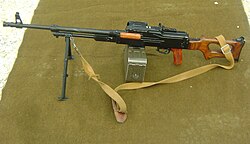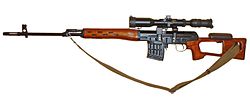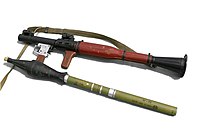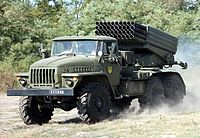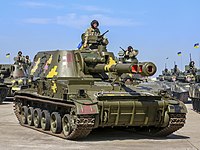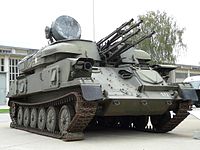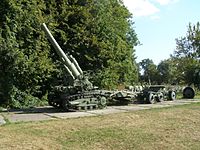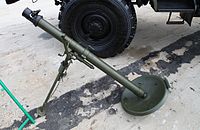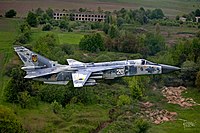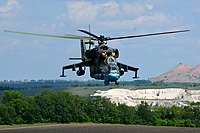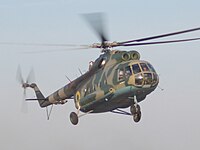Zamorodnian Combined Militia: Difference between revisions
mNo edit summary |
|||
| Line 18: | Line 18: | ||
| website = | | website = | ||
<!-- Leadership --> | <!-- Leadership --> | ||
| commander-in-chief = Oleh Bohdanuk Petrenko | | commander-in-chief = [[Oleh Bohdanuk Petrenko]] | ||
| commander-in-chief_title = Hetman | | commander-in-chief_title = Hetman | ||
| chief minister = | | chief minister = | ||
| Line 177: | Line 177: | ||
|- | |- | ||
|{{wp|RPK|TMK66 DP30}} | |{{wp|RPK|TMK66 DP30}} | ||
| style="background:white;"|[[File: | | style="background:white;"|[[File:Machine Gun RPK.jpg | ||
|250px]] | |||
|{{flag|Velikoslavia}} | |{{flag|Velikoslavia}} | ||
|{{wp|Squad automatic weapon}} | |{{wp|Squad automatic weapon}} | ||
Revision as of 00:34, 31 October 2024
| Zamorodnian Combined Militia | |
|---|---|
| Замородинська Зведена Міліція Zamorodyns'ka Zvedena Militsiya | |
Banner of Hetman Petrenko | |
| Founded | 1742 |
| Leadership | |
| Hetman | Oleh Bohdanuk Petrenko |
| Personnel | |
| Conscription | variable |
| Available for military service | 6,923,316, age 18 to 55 |
| Active personnel | 55,000 to 62,000 |
| Reserve personnel | approx. 2 million |
| Expenditure | |
| Budget | $5.63 billion |
| Percent of GDP | 3.15% |
| Related articles | |
| History | Military history of Zamorodna |
The Zamorodnian Combined Militia (Zamorodnian: Замородинська Зведена Міліція; Zamorodyns'ka Zvedena Militsiya), rarely known as the United Zamorodnian Host, is the unified military of the Zamorodnian Hetmanate. Commanded by the Hetman, the Combined Militia is composed of local militias raised in each of the fifteen stanytsy in Zamorodna. Training, equipment, numbers, and methods of recruitment vary drastically from one stanytsa to the next, but each one is obligated to muster a minimal force determined at the election of a new hetman.
The Combined Militia is rare among professional armed forces in that it has no distinct branches of service. Each militia is effectively treated as its own asset under a unified command structure. As a landlocked country, Zamorodna has a negligible force of riverine vessels placed at the Hetman's command. The country's air power is provided by the Kostyanopol Air Militia and the Barabanopol Air Force which are typically unified into a single division alongside airborne-capable troops.
The exact size of the Combined Militia is difficult to ascertain when forces are not actively mustered. Several stanytsy permit ineligible citizens to train with qualified reservists and in some cases even alongside standing service personnel. Ten of the fifteen stanytsy practice some form of conscription. In general, estimates of active personnel range between 55,000 and 62,000 while the number of reservists may approach two million.
The Zamorodnian Combined Militia procures equipment from a variety of sources. Historically, the Tsardom of Velikoslavia has been the source of much of the Hetmanate's equipment. Over the past several decades, Zamorodna's own arms industry has grown to meet a portion of its domestic demand. Private purchases from global arms and equipment manufacturers have also supplemented domestic and Veliko production. As each stanytsy procures equipment for its respective militias, equipment between units often varies greatly and there are few standards.
History
Historically, the Kvor culture was highly martial with the expectation that every capable man trained as a warrior. The settlement of the Kvor in the region of modern-day Zamorodna gradually challenged the preservation of the roles of warriors in their hosts. However, for the period of Zamorodna's history under the Tsardom of Velikoslavia, these customs were preserved with Kvor osavuls and warriors who sought conflict as a matter of personal honour and valour, even after the Tsardom abolished the right to form hosts.
In this era, Kvor warriors were trained to ride on horseback and fight with bows, spears, lances, and axes. Squadrons of Kvor riders were frequently recruited as mercenaries in foreign countries to act as raiders and scouts behind enemy lines, light cavalry in pitched battles, and dragoons in occupations. Many conservative Kvor warriors were reluctant to adopt gunpowder weapons, opting to continue to train with the bow. Other riders adopted pistols and blunderbusses with enthusiasm, even modifying some with ax heads to create dual-purpose weapons.
Major demographic changes, industrialization, and geopolitical concerns gradually brought about the end of the martial roles of many Kvor. Post-independence, the Staryzamian and Kvor settlers had also been largely assimilated or subsumed by a melting pot "Zamorodnian" culture. The end of the warrior culture necessitated the rise of a professional soldiering class that was more flexible and doctrinally normative than the traditional Kvor riders. With the introduction of the New Compact in 1742, the Hetman was empowered to order the levying of militias and supersede the orders of the local osavuls. This has been widely regarded as the foundation of the Combined Zamorodnian Militia. Each subsequent tenure of a new hetman sees the demands and capabilities of the militia reevaluated, such that they are generally considered to undergo some degree of reorganization, though this is discretionary. The term "Combined Militia" came into use in the 1870s, noting distinctions between different militia units. Prior to this, the unified forces under the command were referred to as the "United Host", though this term is rarely used at present.
Structure and organization
While each stanytsa is responsible for raising a militia for the Hetman, in practice the stanytsy each raise at least two units: one active and one reserve militia. Other stanytsy raise three or four militias accounting for separate conscript forces or air or sea assets.
Zamorodnian militias are official under the unified command of the Hetman and the Hetman's staff who typically hold the rank of luk otaman. Each luk otaman commands a military district of three to five militias. Militias are legally subordinated to Zamorodna's judiciaries. In osavulships, the osavul appoints the judiciary and thus appoints a commander to lead the stanytsa's militia under orders from a luk otaman. In the sovyety, the judiciary is composed of the elected members of the sovyet's rada. In either case, the individual appointed or elected to command the militia holds the rank of vitse-osavul. Other officers beneath a vitse-osavul include the kurenyk, who commands a battalion of 400-800 soldiers, and the sotnyk who commands approximately 100. A platoon-equivalent unit is commanded by an okrugnyk or a hutyrnyk.
Training
The training regimens of Zamorodnian militias are not standardized beyond a set of minimum standards of fitness for military service. Most stanytsy maintain a more stringent standard of fitness than the minimum. In general, the minimum age for enrollment in a militia is 18 years old, though some stanytsy have youth or scouting programs that drill and train youths in military readiness. Active service members are required to train three days per week in peacetime, including general fitness, marksmanship, and survival training. Reservists are subjected to more irregular training with fewer formal requirements. Some reservists are only required to train as little as one weekend per year while others train weekly.
One iconic feature of Zamorodnian military training is the hopak, an acrobatic dance that is frequently taught and practiced as a form of exercise. More recently, the combat hopak has gained traction as a martial arts adaptation of the dance.
Equipment
Infantry equipment
Land vehicles
| Armoured fighting vehicles | |||||
|---|---|---|---|---|---|
| Model | Image | Origin | Type | Armament | Quantity |
| AB Het'man 2000 | 
|
Main battle tank |
|
10 | |
| AB Borsuk 79 | 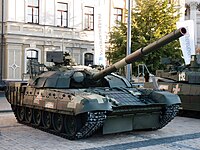
|
Main battle tank |
|
102 | |
| OR Baran 65A | 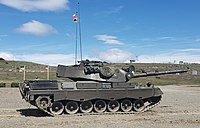
|
Main battle tank |
|
22 | |
| VT Zherebets' 50 | 
|
Heavy tank |
|
>50 | |
| Model | Image | Origin | Type | Armament | Quantity |
| BVV VBV R15 | 
|
Armoured personnel carrier |
|
28 | |
| BVV VBV R19 | 
|
Armoured car |
|
40 | |
| VT VBV-60 | 
|
Armoured personnel carrier |
|
66 | |
| VT VBA-2 | 
|
Armoured car |
|
22 | |
Artillery
| Self-propelled artillery | |||||
|---|---|---|---|---|---|
| Model | Image | Origin | Type | Calibre | Quantity |
| AB T'hir RU69 | MLRS | 40×122mm | 24 | ||
| VT SA78 D48 | Self-propelled howitzer | 122mm | 45 | ||
| VT SA77 D60 | Self-propelled howitzer | 152mm | 31 | ||
| VT TPV70 D9 | Self-propelled anti-aircraft weapon | Quad 23mm | 12 | ||
| Towed artillery | |||||
| Model | Image | Origin | Type | Calibre | Quantity |
| TPtA49 DP333 | Anti-tank gun | 85mm | >5 | ||
| TBPH66 D48 | Howitzer | 122mm | 126 | ||
| AB Molot Bozhyy D80 | Siege howitzer | 203mm | 3 | ||
| VT PPV58 DP56 | Anti-aircraft weapon | Quad 14.5mm | 44 | ||
| Mortars | |||||
| Model | Image | Origin | Type | Calibre | Quantity |
| TVzhM87 DP472 | Heavy mortar | 120mm | ~120 | ||
| TPihM89 DP322 | Medium mortar | 82mm | ~600 | ||
Aircraft
| Fixed-wing aircraft | |||||
|---|---|---|---|---|---|
| Model | Image | Origin | Type | Quantity | Notes |
| VRL95 Horobets' | Multirole combat aircraft | 18 | 4th generation fighter, armed with a 30mm autocannon and nine hardpoints with 4.4 tonnes ordnance capacity | ||
| VShL84 Shturmovyk | Attack aircraft | 9 | 4th generation fighter, armed with a 23mm autocannon and ten hardpoints with 8.0 tonnes ordnance capacity | ||
| VShL70 Blyskavka | Attack aircraft | 18 | 3rd generation fighter, armed with two 23mm autocannons and twelve hardpoints with 4.0 tonnes ordnance capacity | ||
| VVL76 Horbatyy Kyt | Transport/reconnaissance aircraft | 16 | |||
| Helicopters | |||||
| Model | Image | Origin | Type | Quantity | Notes |
| VUH75 Zlyy Lani | Attack helicopter | 21 | Armed with a 12.7mm machine gun, two side-mounted 7.62mm machine guns, hardpoints with 2.3 tonnes ordnance capacity, and can transport 8 troops or 4 stretchers | ||
| VTH73 Stehna | Transport helicopter | 6 | Equipped with six hardpoints with 4.0 tonnes ordnance capacity and can transport 24 troops or 12 stretchers | ||
Ranks and insignia
Officer ranks
| Staff officers | Senior officers | Junior officers | ||||||||
|---|---|---|---|---|---|---|---|---|---|---|
| Rank | Hetman | Koshovyy Otaman† |
Luk Otaman | Osavul† | Vitse-Osavul | Kurenyk | Sotnyk | Vitse-Sotnyk | Okrugnyk | Hutyrnyk |
| Insignia | ||||||||||
†Represents a civil rank which has no formal role in the military hierarchy.
Other ranks
| Senior NCOs | Junior NCOs | Enlisted | ||||||
|---|---|---|---|---|---|---|---|---|
| Rank | Starshyy Horunzhyy |
Horunzhyy | Starshyy Desyatnyk |
Desyatnyk | Vystun | Starshyy Stryletsʹ |
Stryletsʹ | Kursant |
| Insignia | ||||||||














